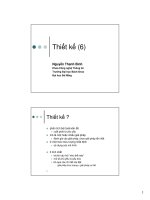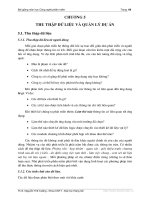Slide công nghệ phần mềm chương 4 requirements engineering
Bạn đang xem bản rút gọn của tài liệu. Xem và tải ngay bản đầy đủ của tài liệu tại đây (1.62 MB, 92 trang )
SOFTWARE
ENGINEERING
Chapter 4 – Requirements Engineering
Jul 2013
Chapter 4. Requirements engineering
Topics covered
• Functional and non-functional requirements
• The software requirements document
• Requirements specification
• Requirements engineering processes
• Requirements elicitation and analysis
• Requirements validation
• Requirements management
2
Jul 2013
Chapter 4. Requirements engineering
3
Requirements engineering
• The process of establishing the services that the customer
requires from a system and the constraints under which it
operates and is developed.
• The requirements themselves are the descriptions of the
system services and constraints that are generated during
the requirements engineering process.
Jul 2013
Chapter 4. Requirements engineering
4
What is a requirement?
• It may range from a high-level abstract statement of a
service or of a system constraint to a detailed
mathematical functional specification.
• This is inevitable as requirements may serve a dual
function
• May be the basis for a bid for a contract - therefore must be open to
interpretation;
• May be the basis for the contract itself - therefore must be defined
in detail;
• Both these statements may be called requirements.
Jul 2013
Chapter 4. Requirements engineering
5
Requirements abstraction (Davis)
“If a company wishes to let a contract for a large software development
project, it must define its needs in a sufficiently abstract way that a
solution is not pre-defined. The requirements must be written so that
several contractors can bid for the contract, offering, perhaps, different
ways of meeting the client organization’s needs. Once a contract has
been awarded, the contractor must write a system definition for the
client in more detail so that the client understands and can validate what
the software will do. Both of these documents may be called the
requirements document for the system.”
Jul 2013
Chapter 4. Requirements engineering
6
Types of requirement
• User requirements
• Statements in natural language plus diagrams of the services the
system provides and its operational constraints. Written for
customers.
• System requirements
• A structured document setting out detailed descriptions of the
system’s functions, services and operational constraints. Defines
what should be implemented so may be part of a contract between
client and contractor.
Jul 2013
Chapter 4. Requirements engineering
User and system requirements
7
Jul 2013
Chapter 4. Requirements engineering
8
Readers of different types of requirements
specification
Jul 2013
Chapter 4. Requirements engineering
9
Functional and non-functional
requirements
• Functional requirements
• Statements of services the system should provide, how the system
should react to particular inputs and how the system should behave
in particular situations.
• May state what the system should not do.
• Non-functional requirements
• Constraints on the services or functions offered by the system such
as timing constraints, constraints on the development process,
standards, etc.
• Often apply to the system as a whole rather than individual features
or services.
• Domain requirements
• Constraints on the system from the domain of operation
Jul 2013
Chapter 4. Requirements engineering
10
Functional requirements
• Describe functionality or system services.
• Depend on the type of software, expected users and the
type of system where the software is used.
• Functional user requirements may be high-level
statements of what the system should do.
• Functional system requirements should describe the
system services in detail.
Jul 2013
Chapter 4. Requirements engineering
11
Case study: MHC-PMS
• The MHC-PMS (Mental Health Care-Patient Management
System) is an information system that is intended for use
in clinics.
• It makes use of a centralized database of patient
information but has also been designed to run on a PC,
so that it may be accessed and used from sites that do
not have secure network connectivity.
• When the local systems have secure network access,
they use patient information in the database but they can
download and use local copies of patient records when
they are disconnected.
Jul 2013
Chapter 4. Requirements engineering
12
MHC-PMS goals
• To generate management information that allows health
service managers to assess performance against local
and government targets.
• To provide medical staff with timely information to support
the treatment of patients.
Jul 2013
Chapter 4. Requirements engineering
13
The organization of the MHC-PMS
Jul 2013
Chapter 4. Requirements engineering
14
MHC-PMS key features
• Individual care management
• Clinicians can create records for patients, edit the information in the
system, view patient history, etc. The system supports data
summaries so that doctors can quickly learn about the key problems
and treatments that have been prescribed.
• Patient monitoring
• The system monitors the records of patients that are involved in
treatment and issues warnings if possible problems are detected.
• Administrative reporting
• The system generates monthly management reports showing the
number of patients treated at each clinic, the number of patients who
have entered and left the care system, number of patients sectioned,
the drugs prescribed and their costs, etc.
Jul 2013
Chapter 4. Requirements engineering
15
MHC-PMS concerns
• Privacy
• It is essential that patient information is confidential and is never
disclosed to anyone apart from authorised medical staff and the
patient themselves.
• Safety
• Some mental illnesses cause patients to become suicidal or a
danger to other people. Wherever possible, the system should
warn medical staff about potentially suicidal or dangerous patients.
• The system must be available when needed otherwise safety may
be compromised and it may be impossible to prescribe the correct
medication to patients.
Jul 2013
Chapter 4. Requirements engineering
16
Functional requirements for the MHCPMS
• A user shall be able to search the appointments lists for
all clinics.
• The system shall generate each day, for each clinic, a list
of patients who are expected to attend appointments that
day.
• Each staff member using the system shall be uniquely
identified by his or her 8-digit employee number.
Jul 2013
Chapter 4. Requirements engineering
17
Requirements imprecision
• Problems arise when requirements are not precisely
stated.
• Ambiguous requirements may be interpreted in different
ways by developers and users.
• Consider the term ‘search’ in requirement 1
• User intention – search for a patient name across all appointments
in all clinics;
• Developer interpretation – search for a patient name in an
individual clinic. User chooses clinic then search.
Jul 2013
Chapter 4. Requirements engineering
18
Requirements completeness and
consistency
• In principle, requirements should be both complete and
consistent.
• Complete
• They should include descriptions of all facilities required.
• Consistent
• There should be no conflicts or contradictions in the descriptions of
the system facilities.
• In practice, it is impossible to produce a complete and
consistent requirements document.
Jul 2013
Chapter 4. Requirements engineering
19
Non-functional requirements
• These define system properties and constraints e.g.
reliability, response time and storage requirements.
Constraints are I/O device capability, system
representations, etc.
• Process requirements may also be specified mandating a
particular IDE, programming language or development
method.
• Non-functional requirements may be more critical than
functional requirements. If these are not met, the system
may be useless.
Jul 2013
Chapter 4. Requirements engineering
20
Types of nonfunctional requirement
Jul 2013
Chapter 4. Requirements engineering
21
Non-functional requirements
implementation
• Non-functional requirements may affect the overall
architecture of a system rather than the individual
components.
• For example, to ensure that performance requirements are met,
you may have to organize the system to minimize communications
between components.
• A single non-functional requirement, such as a security
requirement, may generate a number of related functional
requirements that define system services that are
required.
• It may also generate requirements that restrict existing
requirements.
Jul 2013
Chapter 4. Requirements engineering
22
Non-functional classifications
• Product requirements
• Requirements which specify that the delivered product must
behave in a particular way e.g. execution speed, reliability, etc.
• Organisational requirements
• Requirements which are a consequence of organisational policies
and procedures e.g. process standards used, implementation
requirements, etc.
• External requirements
• Requirements which arise from factors which are external to the
system and its development process e.g. interoperability
requirements, legislative requirements, etc.
Jul 2013
Chapter 4. Requirements engineering
23
Examples of nonfunctional requirements
in the MHC-PMS
Product requirement
The MHC-PMS shall be available to all clinics during normal
working hours (Mon–Fri, 0830–17.30). Downtime within normal
working hours shall not exceed five seconds in any one day.
Organizational requirement
Users of the MHC-PMS system shall authenticate themselves
using their health authority identity card.
External requirement
The system shall implement patient privacy provisions as set out
in HStan-03-2006-priv.
Jul 2013
Chapter 4. Requirements engineering
24
Goals and requirements
• Non-functional requirements may be very difficult to state
precisely and imprecise requirements may be difficult to
verify.
• Goal
• A general intention of the user such as ease of use.
• Verifiable non-functional requirement
• A statement using some measure that can be objectively tested.
• Goals are helpful to developers as they convey the
intentions of the system users.
Jul 2013
Chapter 4. Requirements engineering
25
Usability requirements
• The system should be easy to use by medical staff and
should be organized in such a way that user errors are
minimized. (Goal)
• Medical staff shall be able to use all the system functions
after four hours of training. After this training, the average
number of errors made by experienced users shall not
exceed two per hour of system use. (Testable nonfunctional requirement)









